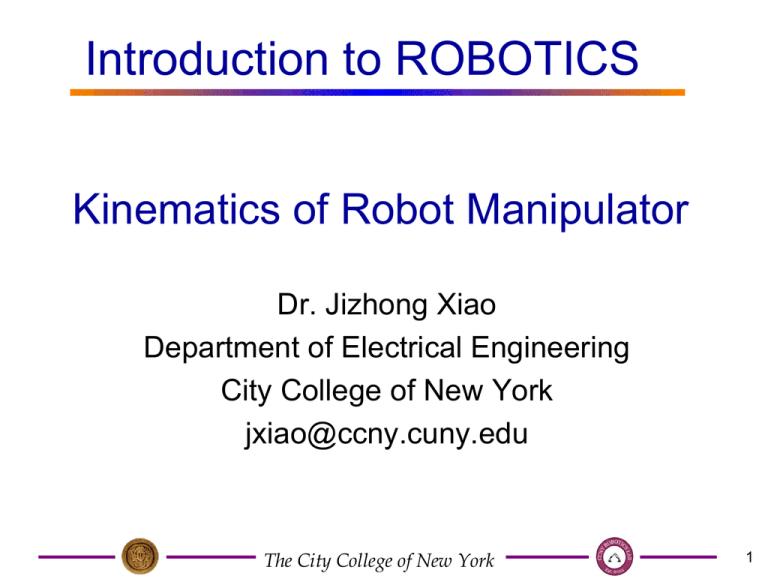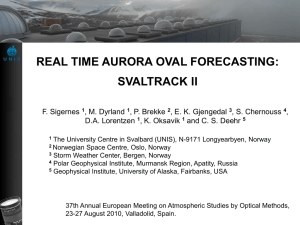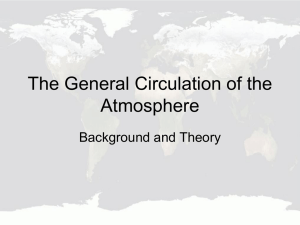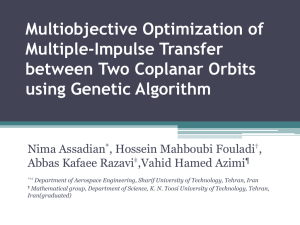ppt format
advertisement

Introduction to ROBOTICS
Kinematics of Robot Manipulator
Dr. Jizhong Xiao
Department of Electrical Engineering
City College of New York
jxiao@ccny.cuny.edu
The City College of New York
1
Outline
• Review
• Robot Manipulators
– Robot Configuration
– Robot Specification
• Number of Axes, DOF
• Precision, Repeatability
• Kinematics
– Preliminary
• World frame, joint frame, end-effector frame
• Rotation Matrix, composite rotation matrix
• Homogeneous Matrix
– Direct kinematics
• Denavit-Hartenberg Representation
• Examples
– Inverse kinematics
The City College of New York
2
Review
• What is a robot?
– By general agreement a robot is:
• A programmable machine that imitates the actions or
appearance of an intelligent creature–usually a human.
– To qualify as a robot, a machine must be able to:
1) Sensing and perception: get information from its surroundings
2) Carry out different tasks: Locomotion or manipulation, do
something physical–such as move or manipulate objects
3) Re-programmable: can do different things
4) Function autonomously and/or interact with human beings
• Why use robots?
–Perform 4A tasks in 4D environments
4A: Automation, Augmentation, Assistance, Autonomous
4D: Dangerous, Dirty, Dull, Difficult
The City College of New York
3
Manipulators
• Robot arms, industrial robot
– Rigid bodies (links) connected
by joints
– Joints: revolute or prismatic
– Drive: electric or hydraulic
– End-effector (tool) mounted
on a flange or plate secured
to the wrist joint of robot
The City College of New York
4
Manipulators
• Robot Configuration:
Cartesian: PPP
Cylindrical: RPP
Spherical: RRP
Hand coordinate:
Articulated: RRR
SCARA: RRP
n: normal vector; s: sliding vector;
(Selective Compliance
Assembly Robot Arm)
a: approach vector, normal to the
tool mounting plate
The City College of New York
5
Manipulators
• Motion Control Methods
– Point to point control
• a sequence of discrete points
• spot welding, pick-and-place, loading & unloading
– Continuous path control
• follow a prescribed path, controlled-path motion
• Spray painting, Arc welding, Gluing
The City College of New York
6
Manipulators
• Robot Specifications
– Number of Axes
• Major axes, (1-3) => Position the wrist
• Minor axes, (4-6) => Orient the tool
• Redundant, (7-n) => reaching around
obstacles, avoiding undesirable
configuration
–
–
–
–
Degree of Freedom (DOF)
Workspace
Payload (load capacity)
Precision v.s. Repeatability
how accurately a specified point
can be reached
how accurately the same position
can be reached if the motion is
Which one is more important?
repeated many times
The City College of New York
7
What is Kinematics
• Forward kinematics
z
Given joint variables
q (q1 , q2 , q3 , q4 , q5 , q6 ,qn )
Y ( x, y, z, O, A, T )
y
x
End-effector position and orientation, -Formula?
The City College of New York
8
What is Kinematics
• Inverse kinematics
End effector position
and orientation
z
( x, y, z, O, A, T )
y
q (q1 , q2 , q3 , q4 , q5 , q6 ,qn )
x
Joint variables -Formula?
The City College of New York
9
Example 1
Forward kinemat ics
x1 l cos
y0
y1
x1
y1 l sin
l
Inversekinemat ics
cos ( x1 / l )
1
The City College of New York
x0
10
Preliminary
• Robot Reference Frames
– World frame
– Joint frame
– Tool frame
z
z
y
x
y
W
R
The City College of New York
T
P
x
11
Preliminary
• Coordinate Transformation
– Reference coordinate frame
OXYZ
– Body-attached frame O’uvw
z
P
Point represented in OXYZ:
Pxyz [ px , py , pz ]
Pxyz px i x p y jy pz k z
T
Point represented in O’uvw:
Puvw pu i u pv jv pwk w
Two frames coincide ==>
y
w
v
O, O’
u
x
pu px pv py pw pz
The City College of New York
12
Preliminary
Properties: Dot Product
3
Let x and y be arbitrary vectors in R and be
the angle from x to y , then
x y x y cos
Properties of orthonormal coordinate frame
• Mutually perpendicular
i j 0
i k 0
k j 0
• Unit vectors
The City College of New York
| i | 1
| j | 1
| k | 1
13
Preliminary
• Coordinate Transformation
z
– Rotation only
Pxyz px i x p y jy pz k z
Puvw pu i u pv jv pwk w
P
y
w
v
Pxyz RPuvw
u
x
How to relate the coordinate in these two frames?
The City College of New York
14
Preliminary
• Basic Rotation
– px , p y, and p z represent the projections of P
onto OX, OY, OZ axes, respectively
– Since P pu i u pv jv pwk w
px i x P i x i u pu i x jv pv i x k w pw
py jy P jy i u pu jy jv pv jy k w pw
pz k z P k z i u pu k z jv pv k z k w pw
The City College of New York
15
Preliminary
• Basic Rotation Matrix
px i x i u
p j i
y y u
p z k z i u
i x jv
j y jv
k z jv
i x k w pu
j y k w pv
k z k w pw
– Rotation about x-axis with
1 0
Rot( x, ) 0 C
0 S
0
S
C
z
w
P
v
u
y
x
The City College of New York
16
Preliminary
• Is it True?
– Rotation about x axis with
0
px 1
p 0 cos
y
pz 0 sin
pu
sin pv
cos pw
0
z
w
P
p x pu
p y pv cos pw sin
p z pv sin pw cos
v
u
y
x
The City College of New York
17
Basic Rotation Matrices
– Rotation about x-axis with
1 0
Rot( x, ) 0 C
0 S
0
S
C
– Rotation about y-axis with
C
Rot( y, ) 0
S
– Rotation about z-axis with
Pxyz RPuvw
C
Rot( z , ) S
0
The City College of New York
S
1 0
0 C
0
S
C
0
0
0
1
18
Preliminary
• Basic Rotation Matrix
i x i u i x jv i x k w
Pxyz RPuvw
R jy i u jy jv jy k w
k z i u k z jv k z k w
– Obtain the coordinate of Puvw from the coordinate
Dot products are commutative!
of Pxyz
pu i u i x
p j i
v v x
pw k w i x
i u jy
jv j y
k w jy
i u k z px
jv k z p y
k w k z p z
QR RT R R1R I3
Puvw QPxyz
Q R1 RT
<== 3X3 identity matrix
The City College of New York
19
Example 2
• A point auvw (4,3,2) is attached to a rotating frame,
the frame rotates 60 degree about the OZ axis of
the reference frame. Find the coordinates of the
point relative to the reference frame after the
rotation.
a xyz Rot( z ,60)auvw
0.5 0.866 0 4 0.598
0.866
0.5
0 3 4.964
0
0
1 2 2
The City College of New York
20
Example 3
• A point axyz (4,3,2) is the coordinate w.r.t. the
reference coordinate system, find the
corresponding point auvw w.r.t. the rotated
OU-V-W coordinate system if it has been
rotated 60 degree about OZ axis.
auvw Rot( z ,60)T a xyz
0.866 0 4 4.598
0.5
0.866 0.5 0 3 1.964
0
0
1 2 2
The City College of New York
21
Composite Rotation Matrix
• A sequence of finite rotations
– matrix multiplications do not commute
– rules:
• if rotating coordinate O-U-V-W is rotating about
principal axis of OXYZ frame, then Pre-multiply
the previous (resultant) rotation matrix with an
appropriate basic rotation matrix
• if rotating coordinate OUVW is rotating about its
own principal axes, then post-multiply the
previous (resultant) rotation matrix with an
appropriate basic rotation matrix
The City College of New York
22
Example 4
• Find the rotation matrix for the following
operations:
Rotation about OY axis
Rotation about OW axis
Rotation about OU axis
Answer...
R Rot( y, ) I 3 Rot( w, ) Rot(u, )
C 0
0 1
- S 0
CC
S
SC
S C S 0 1 0
0
0 S C 0 0 C S
C 0
0
1 0 S C
SS CSC CSS SC
CC
CS
SSC CS CC SSS
Pre-multiply if rotate about the OXYZ axes
Post-multiply if rotate about the OUVW axes
The City College of New York
23
Coordinate Transformations
• position vector of P
in {B} is transformed
to position vector of P
in {A}
• description of {B} as
seen from an observer
in {A}
Rotation of {B} with respect to {A}
Translation of the origin of {B} with respect to origin of {A}
The City College of New York
24
Coordinate Transformations
• Two Special Cases
A P A
B P A o'
r RB r r
1. Translation only
– Axes of {B} and {A} are
parallel
A
RB 1
2. Rotation only
– Origins of {B} and {A}
are coincident
r 0
A o'
The City College of New York
25
Homogeneous Representation
• Coordinate transformation from {B} to {A}
A P A
r RB B r P Ar o'
A
A o'
r
RB
r B r P
1 1
1 013
• Homogeneous transformation matrix
A P
RB
TB
013
A
A
r R33
1 0
A o'
P31
1
Scaling
The City College of New York
Rotation
matrix
Position
vector
26
Homogeneous Transformation
• Special cases
1. Translation
I 33
A
TB
013
r
1
A o'
2. Rotation
A
RB
A
TB
013
031
1
The City College of New York
27
Example 5
• Translation along Z-axis with h:
1
0
Trans( z , h)
0
0
0
1
0
0
0
0
1
0
x 1
y 0
z 0
1 0
0
0
h
1
z
0
1
0
0
0
0
1
0
0 pu pu
0 pv pv
h pw pw h
1 1 1
z
P
P
y
w
y
w
v
v
O, O’
u
x
h
O, O’
The City College of New York
u
x
28
Example 6
• Rotation about the X-axis by
1 0
0 C
Rot( x, )
0 S
0 0
0
0
0
1
0
S
C
0
z
w
x 1 0
y 0 C
z 0 S
1 0 0
P
u
x
The City College of New York
0
S
C
0
0 pu
0 pv
0 p w
1 1
v
y
29
Homogeneous Transformation
• Composite Homogeneous Transformation
Matrix
• Rules:
– Transformation (rotation/translation) w.r.t
(X,Y,Z) (OLD FRAME), using premultiplication
– Transformation (rotation/translation) w.r.t
(U,V,W) (NEW FRAME), using postmultiplication
The City College of New York
30
Example 7
• Find the homogeneous transformation matrix
(T) for the following operations:
Rotation about OX axis
T ranslation of a alongOX axis
T ranslation of d alongOZ axis
Rotationof about OZ axis
T Tz , Tz ,dTx,aTx, I 44
Answer :
C
S
0
0
S
C
0
0
0
0
1
0
0 1
0 0
0 0
1 0
0
1
0
0
0
0
1
0
0 1
0 0
d 0
1 0
0
1
0
0
The City College of New York
0
0
1
0
a 1 0
0 0 C
0 0 S
1 0 0
0
S
C
0
0
0
0
1
31
Homogeneous Representation
• A frame in space (Geometric
Interpretation)
z
R33 P31
F
1
0
nx
n
F y
nz
0
sx
sy
sz
0
ax
ay
az
0
P( px , py , pz )
a (z’)
s(y’)
n (X’)
px
p y
pz
1
y
x
Principal axis n w.r.t. the reference coordinate system
The City College of New York
32
Homogeneous Transformation
• Translation
1
0
Fnew
0
0
nx
n
y
nz
0
a
0 0 d x nx s x
1 0 d y n y s y
0 1 d z nz s z
0 0 1 0 0
sx ax px d x
s y a y p y d y
sz az pz d z
0 0
1
ax
ay
az
0
px
p y
pz
1
z
s
n
a
s
n
y
Fnew Trans(d x , d y , d z ) Fold
The City College of New York
33
Homogeneous Transformation
Composite Homogeneous Transformation Matrix
z1
z2
y2
z0
0
y1
A1
y0
1
A2
x1
x0
?
i 1
0
x2
A2 0A11 A2
Ai
Transformation matrix for
adjacent coordinate frames
Chain product of successive
coordinate transformation matrices
The City College of New York
34
Example 8
a
• For the figure shown below, find the 4x4 homogeneous transformation
matrices i 1 A and 0 Ai for i=1, 2, 3, 4, 5
i
0
1 0 0
n
s
a
p
x
x
x
x
c
0 0 1 e c
n s a p 0
y
y
y
A1
z3
F y
0 1 0 a d
b
nz s z a z p z
y3 x
3
0
0
0
1
d
z5
0 0 0 1
x5
b
0 1 0
y5
0 0 1 a d
z4
e
1
A2
1 0 0
y4
0
z2
x4
x2
0
0
0
1
y
z1
z0
x0
x1
2
y1
y0
Can you find the answer by observation
based on the geometric interpretation of
homogeneous transformation matrix?
The City College of New York
0
1
0
A2
0
0
1
0
0
0
0 b
0 e c
1
0
0
1
35
Orientation Representation
R33
F
0
P31
1
• Rotation matrix representation needs 9
elements to completely describe the
orientation of a rotating rigid body.
• Any easy way?
Euler Angles Representation
The City College of New York
36
Orientation Representation
• Euler Angles Representation ( , , )
– Many different types
– Description of Euler angle representations
Euler Angle I
Sequence
of
about OU axis
about OZ axis
Rotations about OW axis
Euler Angle II
Roll-Pitch-Yaw
about OZ axis
about OX axis
about OV axis
about OY axis
about OW axis
The City College of New York
about OZ axis
37
Euler Angle I, Animated
w'= z
w'"= w"
v'"
v"
v'
y
u'"
u' =u"
x
The City College of New York
38
Orientation Representation
• Euler Angle I
cos sin
Rz sin
cos
Rw''
0
cos
sin
0
0
sin
cos
0
0
0
1
0 , Ru ' 0 cos
0 sin
1
0
0
1
The City College of New York
sin ,
cos
0
39
Euler Angle I
Resultant eulerian rotation matrix:
R Rz Ru ' Rw''
cos cos
sin sin cos
sin cos
cos sin cos
sin sin
cos sin
sin cos cos
sin sin
cos cos cos
cos sin
The City College of New York
sin sin
cos sin
cos
40
Euler Angle II, Animated
w'= z
w"'= w"
v"'
v' =v"
y
u"'
Note the opposite
(clockwise) sense of the
third rotation, .
u'
u"
x
The City College of New York
41
Orientation Representation
• Matrix with Euler Angle II
sin sin
cos cos cos
cos sin
sin cos cos
cos sin
sin cos
sin cos cos
cos cos
sin cos cos
sin sin
cos sin
sin sin
cos
Quiz: How to get this matrix ?
The City College of New York
42
Orientation Representation
• Description of Roll Pitch Yaw
Z
Y
X
Quiz: How to get rotation matrix ?
The City College of New York
43
Thank you!
Homework 1 is posted on the web.
Next class: kinematics II
z
z
z
y
y
x
z
x
y
x
y
x
The City College of New York
44









